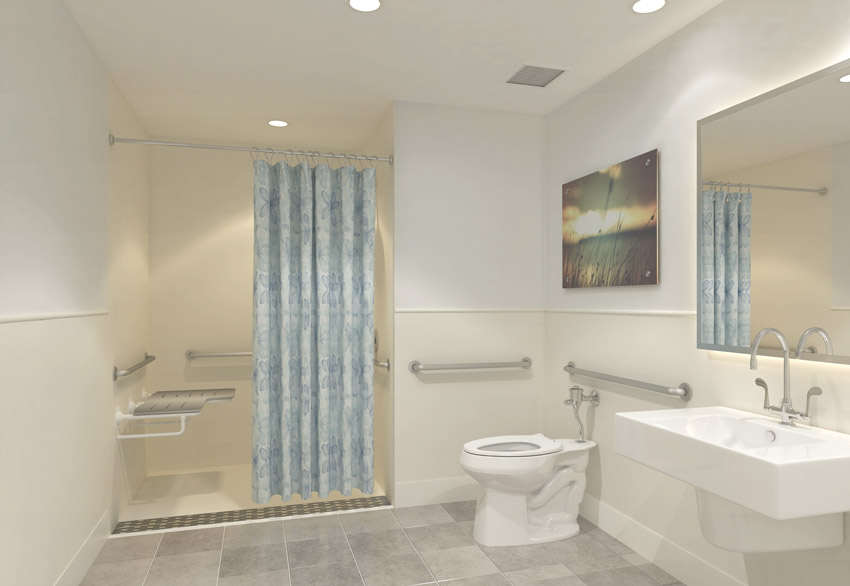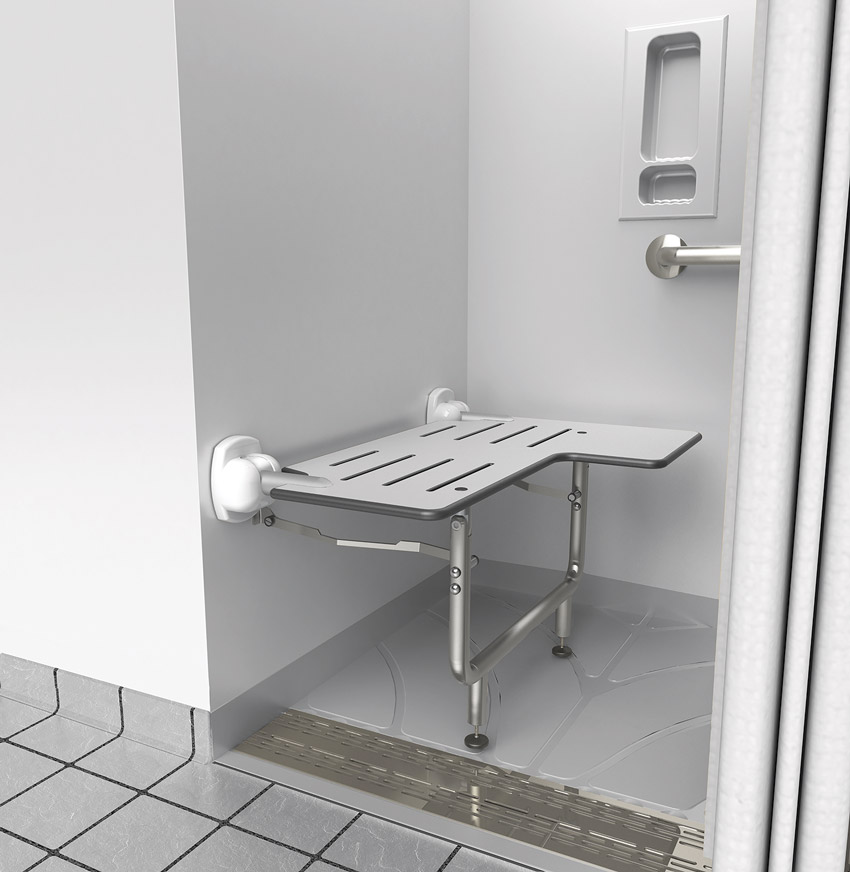Taking Accessibility to a New Level
SELECTING THE RIGHT PRODUCTS
When it comes to designing ADA and universal design projects, there are a number of things to keep in mind when evaluating and ultimately specifying bathroom products.
For starters, products should be durable, aesthetically pleasing, and easily maintained.
“Restroom/toilet partitions should be kept simple and yet be able to support the weight of grab bars, toilet-paper holders, and clothing hooks,” adds Mary Fisher Knott, CID, allied ASID, CLIPP, CAPS, CEO of Ergonomic Design Center, Scottsdale, AZ.
Beyond ADA requirements, which will be discussed in detail below, Burnette explains that common-sense ergonomics should go into product selection. A few pointers include:
- Incorporate comfortable grip diameter and surface finishes.
- Include intuitive usage details, such as simple dispensing or hands-free dispensing of paper towels, soap, and hand sanitizers.
- Avoid large, bulky, vendor-supplied towel, soap, and napkin dispensers that take a disproportionate amount of wall space, thereby causing reach conflicts or unsightly fixtures.
- Incorporate hands-free faucets and auto-flush to not only minimize the need to reach from a wheelchair but also reduce health-care associated infections (HAI) by eliminating surface touching.
Meanwhile, Eric Koffler, AIA, IIDA, EDAC, LEED AP, WELL AP, senior associate designer, NBBJ, Columbus, Ohio, emphasizes safety and infection prevention. For instance, floor surfaces that meet or exceed dynamic coefficient of friction requirements should be specified to reduce the likelihood of slips and falls.
Furthermore, it is important to reduce areas that can harbor microbes—such as depressions, corners, and anywhere two different finishes/products come together—as they can be hard to clean and harbor unwanted microorganisms over time. “Selecting monolithic finishes, such as large-format tile on walls, will reduce grout lines, and specifying countertops with integral sinks are a few measures that can assist enhanced hygiene,” Koffler says.
A common stereotype is that ADA and universal designs are cold and institutional. Not only is this no longer the case, but manufacturers also continue to introduce attractive, aesthetic product options.
For example, new solid-surface and man-made materials are available in solid and subdued patterns that can be used in a simple, monochromatic scheme to create a more elegant feel, relates Fisher Knott. Porcelain tiles can also be employed on horizontal and lateral surfaces to create a warm subtle pallete.
FUNCTIONAL AND STYLISH
In line with general industry trends blurring the lines between commercial and residential design, manufacturers are offering high-performance finishes, fixtures, and accessories with a wider range of styles, finishes, and colors.
In addition to selecting the right products, Burnette recommends a few ways to enhance the overall ambiance and aesthetics of the bathroom. For example, safe lighting levels can be achieved with warmer color tones in the 2,700 to 3,000 Kelvin range. Similarly, warmer colors, and sometimes brighter-colored hardware can be considered for grab bars, dispensing, and fixtures to add a stylish touch that deviates from the expected stainless steel, chrome, and other institutional color options.
Burnette also points out that because base cabinets under sinks in ADA bathrooms are not allowed, the plumbing below the fixture is typically very visible. Adding a shroud over the hardware and P-trap will hide unsightly plumbing.
Overall, Burnette applauds the industry for introducing a variety of visually appealing bathroom products. But even so, designers are still grappling with the challenge of successfully integrating these products into the full bathroom setting.
For instance, finding and locating attractive dispensers for toilet tissue, paper towels, soap, and feminine napkins that do not conflict with maximum reach or clearances between grab bars can be a challenge. Generally, this will take more wall space than anticipated, so early designs of wall elevations for each bathroom wall are recommended.

Photo courtesy of Inpro
Bathrooms in health-care facilities are opportunities for universal design, which may include additional grab bars, turning space exceeding ADA minimums, and ample space for caregivers to provide assistance.
“Providing ADA-compliant turning space and fixture clearances that do not make the ADA-compliant bathrooms feel stigmatized or overly institutional compared to other bathrooms is another challenge,” Burnette relates. “One way to offset the ADA bathroom from feeling oversized is to increase the clearances in all bathrooms to be universally designed for most movement needs, a.k.a., ‘mobility friendly.’”
Another point of potential difficulty can occur specifying finish transitions; in particular, incorporating a water-resistant flooring finish in the bathroom and finish transition at the door threshold to the bedroom zone. “Quite often, a thicker tile product is used and must be transitioned at the door threshold with a solid-surface sill to provide the finish transition,” Burnette adds.
This sill, even with a sloped edge, can still be a trip hazard. Fortunately, there are more products that can replace tile that are closer in thickness to the typical sheet goods or luxury vinyl tile in commercial applications; for example, resinous flooring and newer sheet goods that can withstand the water overspray, says Burnette.
“The same challenge is true at the shower edge. ADA guidelines allow a curb in non-roll-in showers with a transfer movement into these showers. This curb presents a trip hazard to all patients with trouble lifting their feet, or with vision impairments,” he explains.
To address this, there are numerous shower products that provide a trench drain shower design with no raised curb between the shower and bathroom floor.
ADA-COMPLIANT YET NOT FULLY FUNCTIONAL SPACES
The above example illustrates another challenging aspect of ADA designs, which is the fact that code compliant does not always translate into fully functional spaces, and this is where designers need to step in to make these designs really work.
Granted, the ADA—or more specifically, the U.S. Department of Justice—has established a line of communication with the design community for continual feedback and refinements on behalf of disabled advocacy groups, owners, and designers. But even so, issues and challenges still arise.
While specific to hospital settings, one example is providing adequate changing space within the bathroom for patients to take showers or change clothes within the bathroom. Burnette explains that most hospital bed units are working within a column grid spacing that allows two patient rooms per column bay, and this module of repetitive space across the floor requires creative layouts for the 10 percent and higher ratios of ADA-compliant rooms. However, because the dressing bench and adjacent access space is not a requirement in private patient bathrooms, there is often insufficient space for disabled patients to manage within the space confines of the bathroom.
Similarly, the toilet room in health-care facilities might technically be ADA compliant but not properly account for sufficient space to accommodate caregiver assistance.
Other environments, such as an outpatient clinic, may serve a higher percentage of patients on scooters who require more space for their turn radius than what is required by ADA standards.
Overall, designers should consider exceeding ADA requirements based upon user needs. This could mean greater space allocation, altered layouts, shorter reach ranges, or the addition of grab bars.
In some cases, a functional design modification might be as simple as locating a paper-towel dispenser immediately adjacent to the wheelchair-accessible lavatory so that a wheelchair user does not have to wheel with wet hands in order to reach the towel dispenser, suggests Heersema. “Also, consider users with arthritis or multiple sclerosis, who may have difficulty extending their fingers. Specifying a ‘hands-under’ dryer may be more preferable than a ‘hands-in’ dryer for these users.”
Similarly, door locks and toilet-flushing mechanisms should be easily operated, with no grasping, pinching, or twisting of the wrist.

Photo courtesy of Inpro
With the installation of trench drains, showers can be curbless with no threshold for easy access.
Notice


www.scrantonproducts.com









